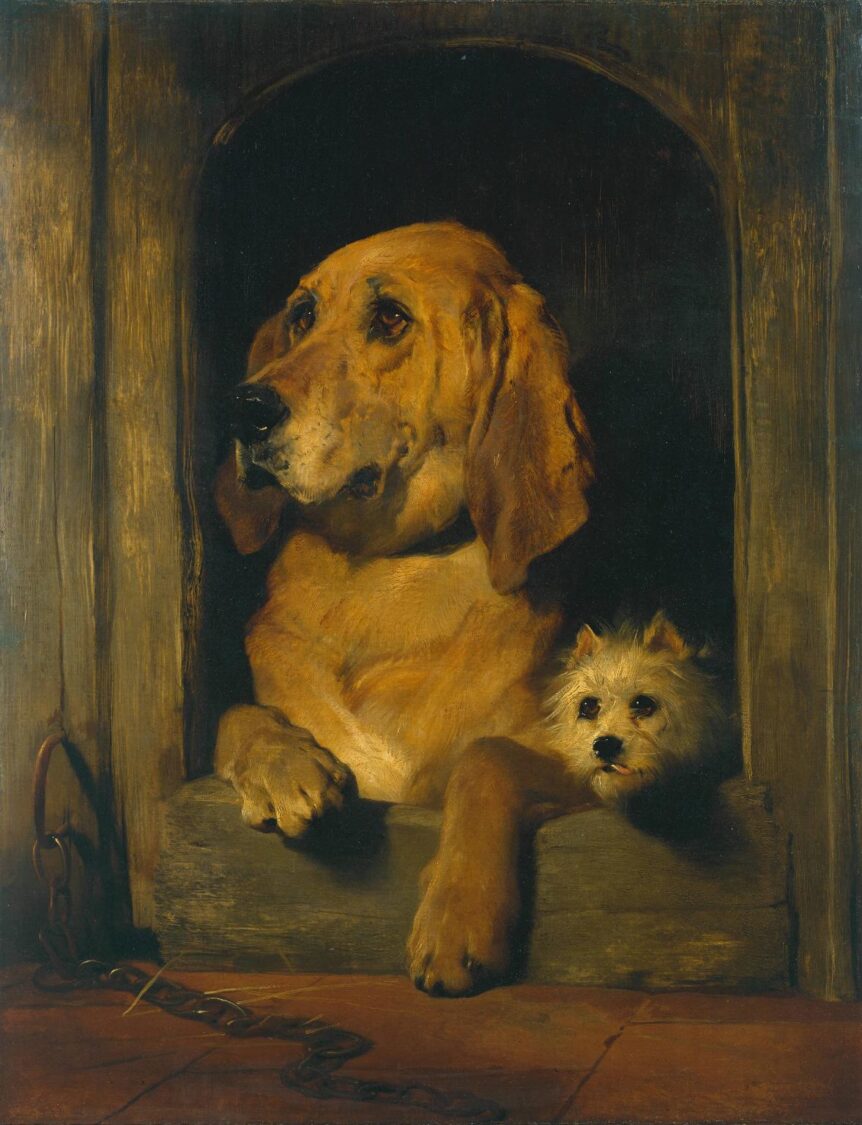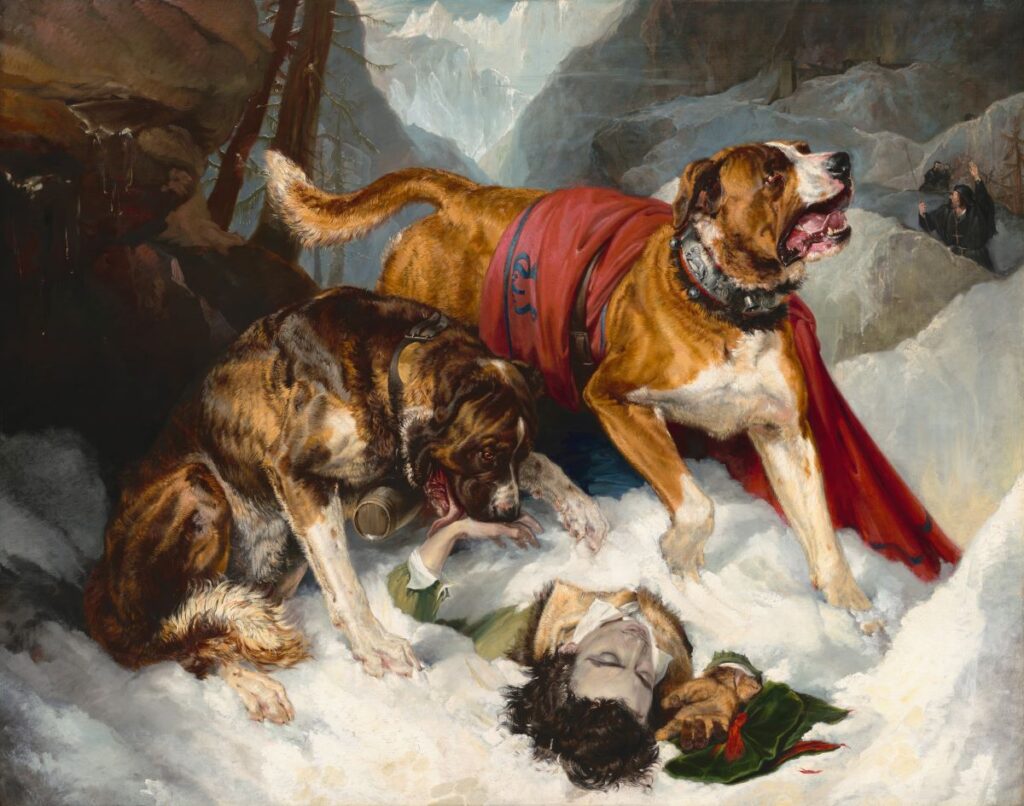
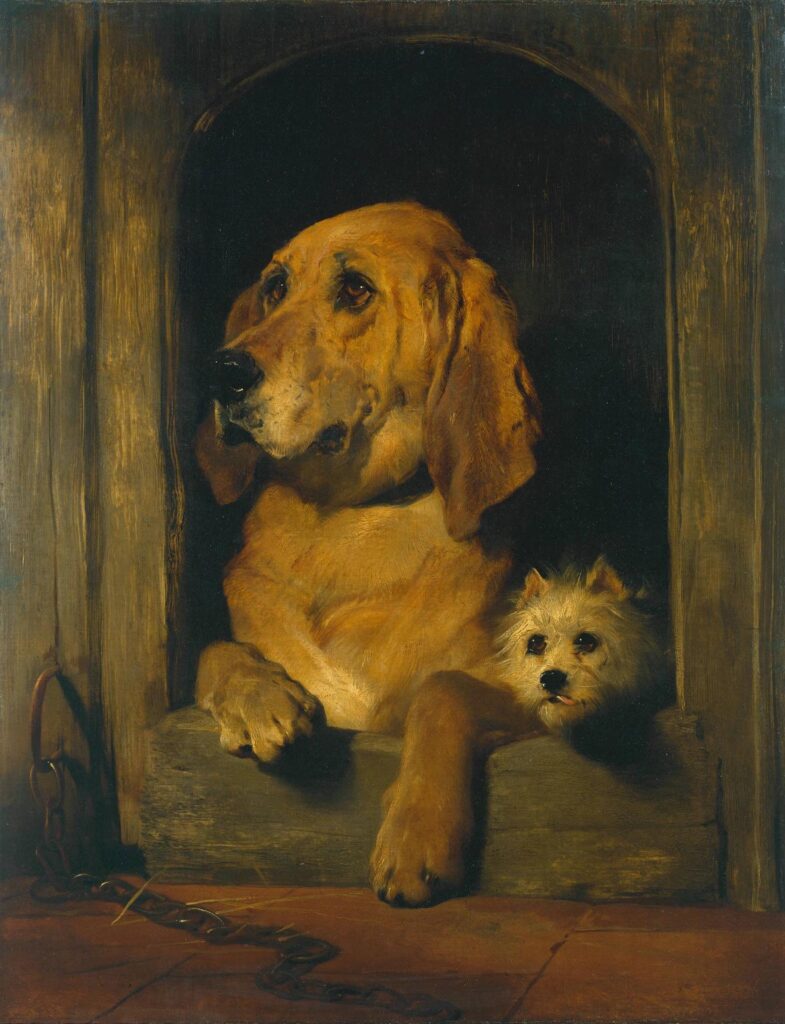
For as long as we have been able to live with them, dogs have played an integral part in the human enterprise. In many parts of the world, they are still working animals, given neither names nor access to their owners’ homes. In other places, they lead pampered lives, sharing food, shelter, and even beds with their owners. In many Western societies, particularly in the nineteenth century, it was common for dog lovers with ample means to commission portraits of their pets in two or three dimensions. Some were even preserved by taxidermy for domestic display.
Among the best-known nineteenth-century artists in this field was Sir Edwin Landseer, Queen Victoria’s favorite wildlife artist. In some of his best-known paintings, such as Alpine Mastiffs Reanimating a Distressed Traveller, which depicts two dogs making a heroic rescue (Fig. 1), he relies on human drama to animate his canine subjects. In others, such as Dignity and Impudence, a double portrait dating from the late 1830s (Fig. 2), he anthropomorphizes the dogs he depicts, at least with his title, if not with the poses he adopts. While very different in character, both of these works remain popular today, in part because of their flawless painterly qualities, but also because they succeed in evoking emotional reactions from viewers.
Landseer was a master at capturing the personalities of his sitters and elevating their physical characteristics to almost saint-like status, but he was not alone in making captivating portraits of dogs. Barbaro after the Hunt, of about 1858, is among several great dog paintings by the French artist Rosa Bonheur (Fig. 3). In this, the doleful eyes of her dog expressing its wish to be finished with its after-the-hunt bath, tug at our heartstrings and reflect the close personal relationship Bonheur had with many of her subjects.
Few sculptors have been able to capture the same level of intimate detail and personality as Landseer or Bonheur when presenting dogs in three dimensions. Anna Hyatt Huntington was one who did. The pair of bronze Great Danes she created in 1907 (Fig. 4) and her Greyhounds Playing of 1936 (Fig. 7) are just two of the many formidable dog sculptures she made based on animals with which she lived daily. Henri-Alfred Jacquemart was another. His Hound and the Tortoise (Fig. 6), made three quarters of a century before Huntington’s greyhounds, has the same intimate feel, capturing a moment in time and the personality of a dog the artist clearly knew well.
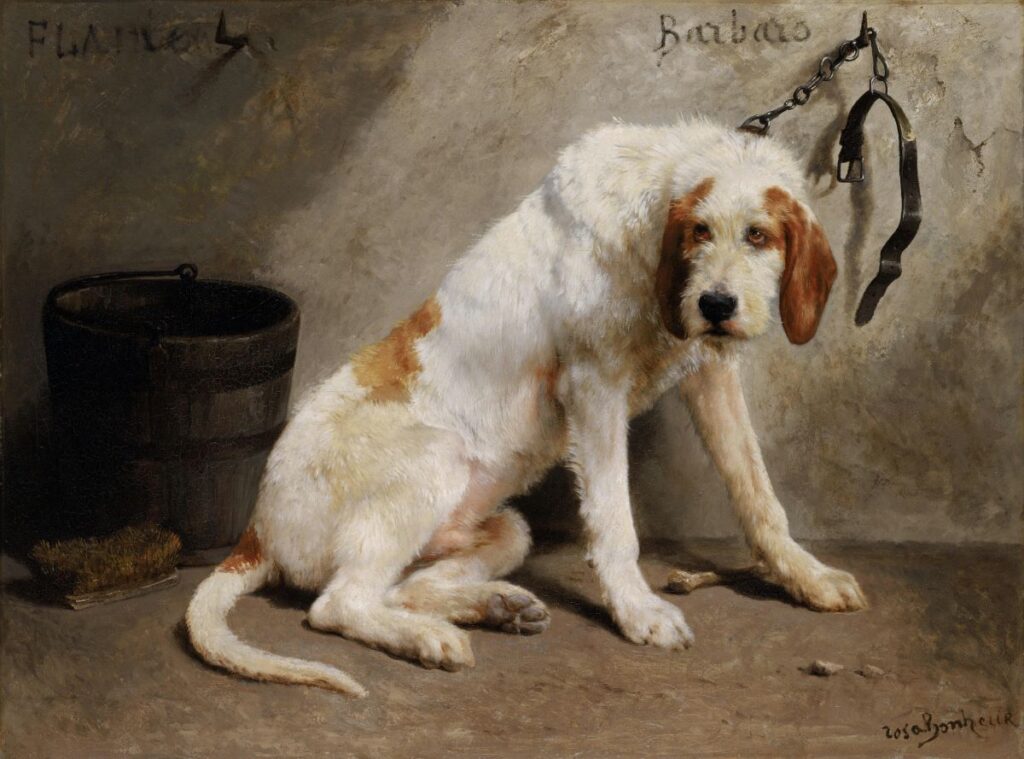
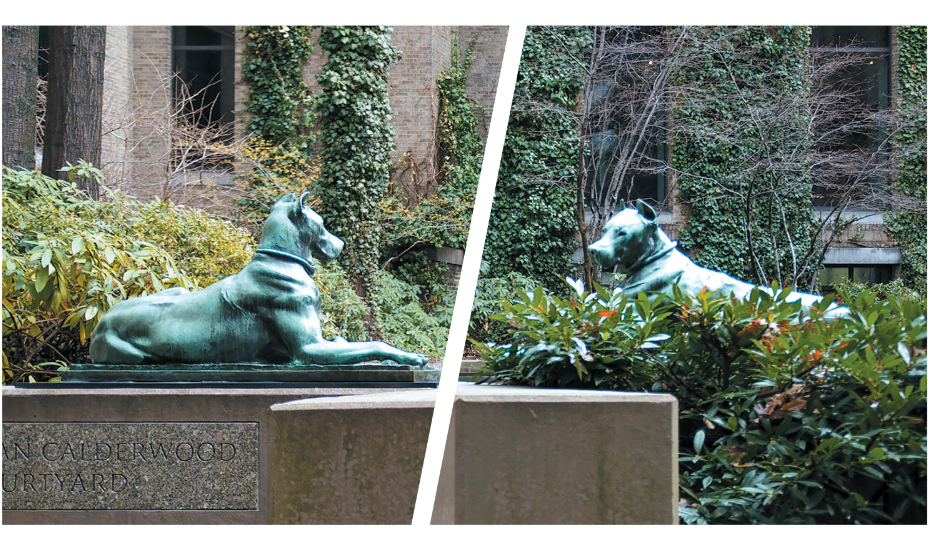
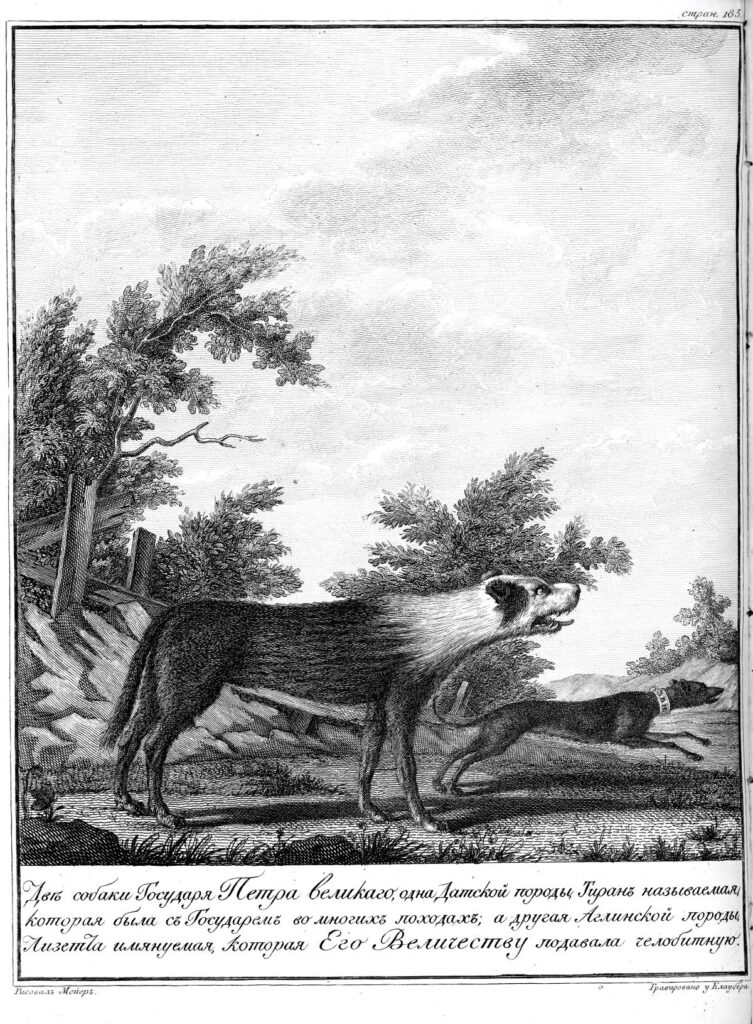
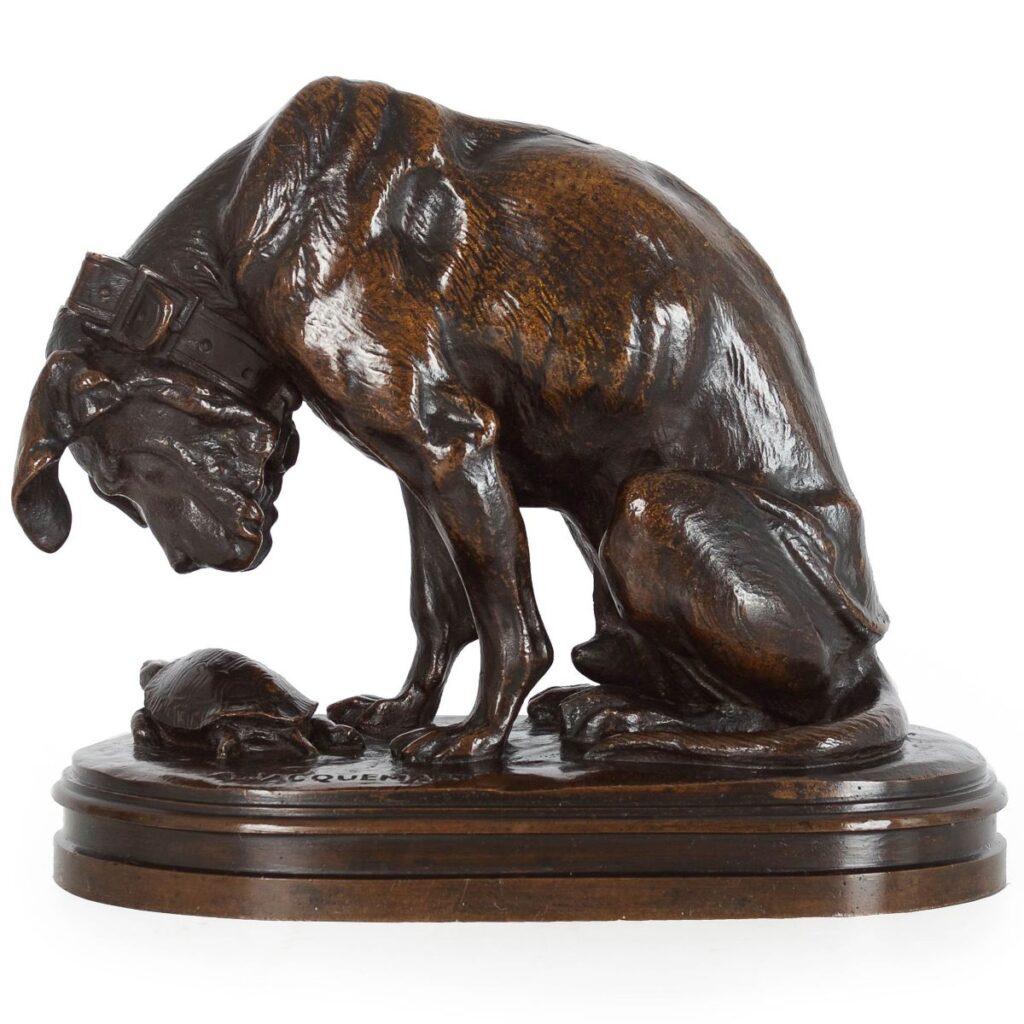
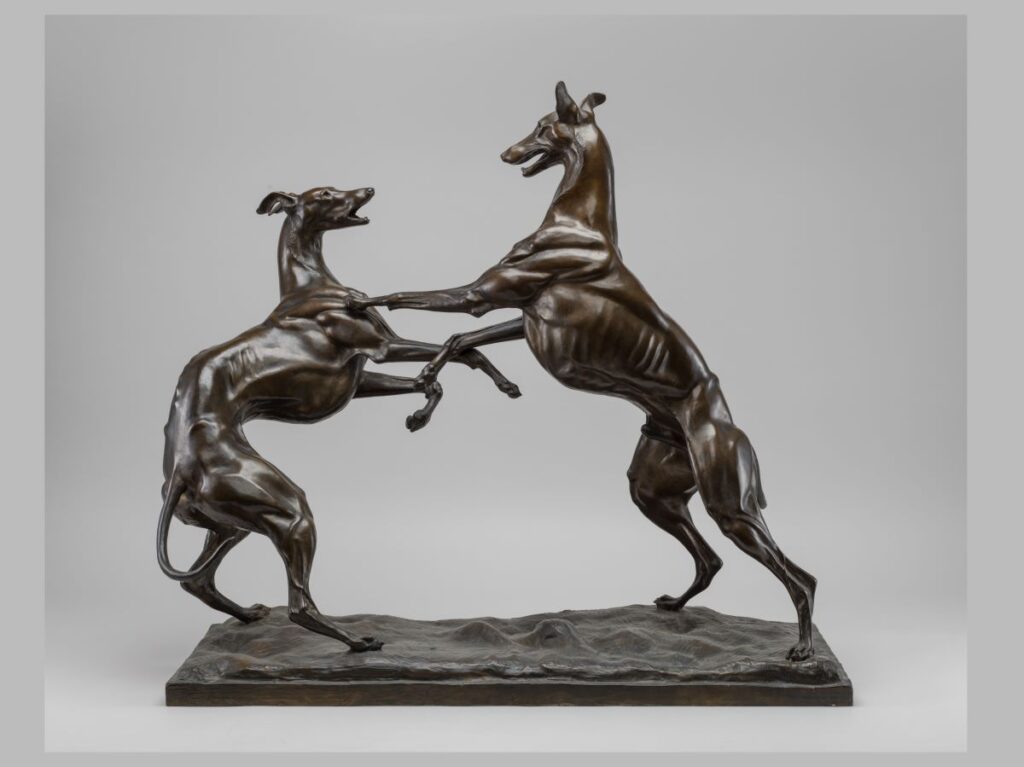
While modern day taxidermy did not come into its own until a century later, the physical preservation of beloved dogs goes back to the early eighteenth century. Among the oldest examples to survive are two hunting dogs that once belonged to Peter the Great. These were mounted around 1720 and are now on display at the zoological museum of the Russian Academy of Sciences in the city that bears the czar’s name (Fig. 5). A large display of popular dog breeds can be seen near them at the same museum. These were mounted (more professionally) during the Soviet era by the museum’s taxidermist, Mikhail Abramovich Zaslavsky (1921–1993), who worked there from 1946 to 1989.1
Like the czar’s, some dogs were preserved as much for the fame of their owner as for their own accomplishments. The Museum of Hygiene in Saint Petersburg has one of the dogs used by Ivan Pavlov (1849–1936) in his landmark studies of dog behavior. However, most of the dogs that earned physical immortality, did so through their own behavior. Taxidermied “celebrity” dogs, from war heroes to prize winners, can be found in museums around the world. Among my favorites are: Barry der Menschenretter (Barry the Lifesaver), a Saint Bernard who lived from 1800 to 1814 and was credited with rescuing more than forty snow-bound travelers in the Alps in the early nineteenth century (Fig. 8); and Owney, a terrier mix adopted as the first unofficial mascot of the US Postal Service in about 1888 (Fig. 9). He lived from about 1887 to 1897 and ended up traveling to all forty-eight contiguous states and overseas on behalf of the Post Office. And, of course, there is Balto, the huskie who lived from 1919 to 1933 and led the last of a series of sled-dog teams that carried, by relay, a desperately needed supply of antitoxin to Nome, Alaska, during a deadly outbreak of diphtheria in the winter of 1925. Balto’s mounted skin is preserved at the Cleveland Museum of Natural History. A life-size bronze of the dog by Frederick George Richard Roth gives him a much-beloved outdoor presence in New York City’s Central Park (Fig. 16).
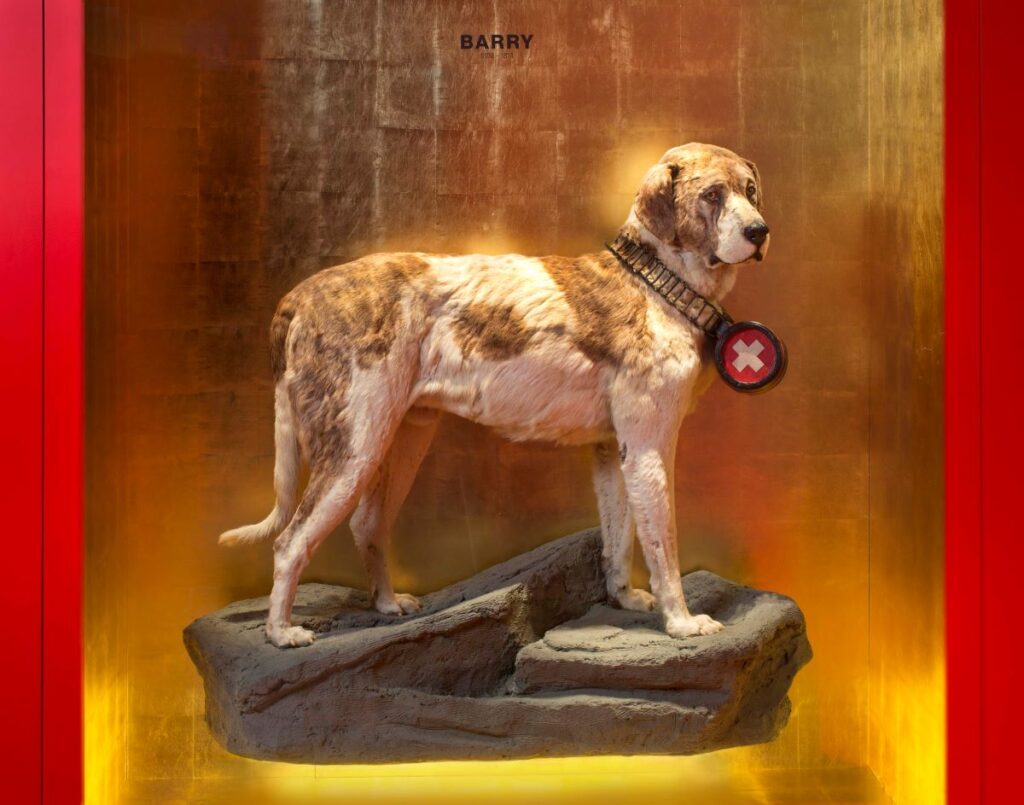
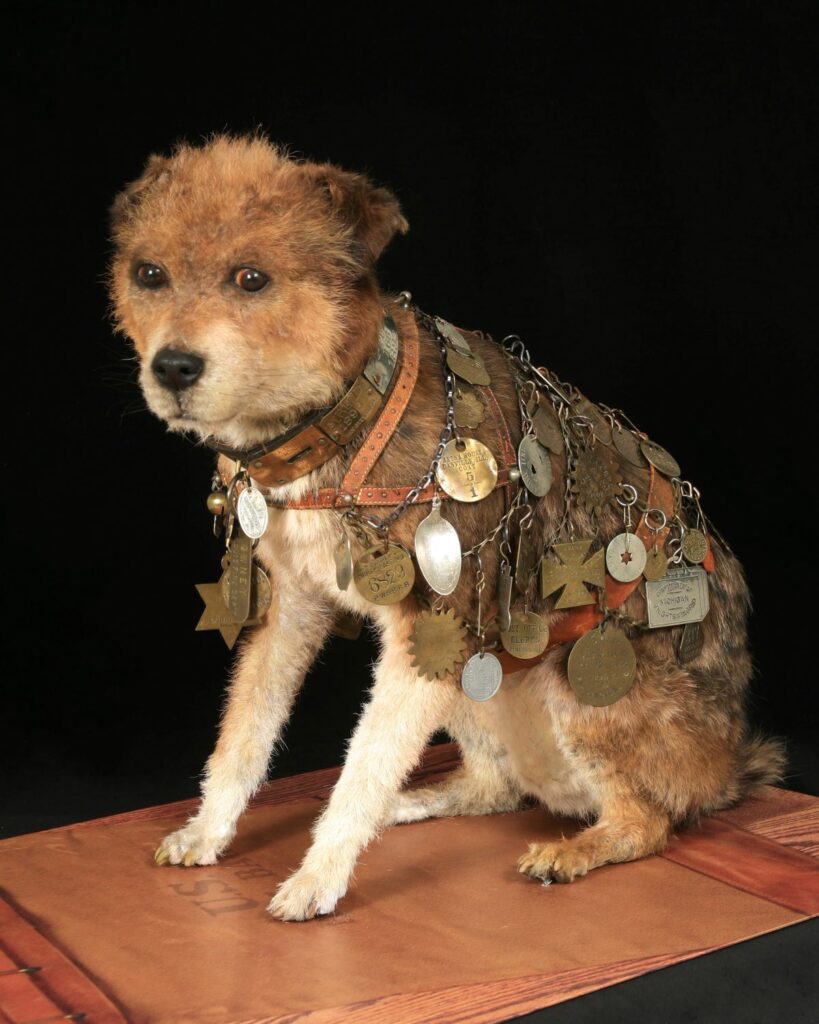
Apart from paintings, sculptures, and taxidermied specimens, the most tangible record of the long relationship between canines and their owners are the many dog collars that survive. Collars are the subject of an ambitious exhibition organized by the National Sporting Library and Museum (NSLM) in Middleburg Virginia, and recently on view at the American Kennel Club’s Museum of the Dog in New York City. Soon to be on display at Pebble Hill Plantation in Thomasville, Georgia, the exhibition is based on selections from a group of 187 dog collars given to the NSLM by collectors Timothy and Jocelyn Greenan in 2014.
“Dog collars have, in many ways, always been ephemeral objects with little enduring significance,” notes Timothy Greenan. “[They are] often buried with the dog and sadly lost to history. Those that have survived tell a story.”2 The stories they tell cover their range of uses, including the two chosen for the title of the exhibition: identity and restraint. But they have also been used for protection, most notably in the spiked collars worn by fighting dogs (Figs. 10, 12). Some are ostentatiously beautiful (Figs. 11, 13), while others are subtly understated and elegant (Figs. 14, 15).
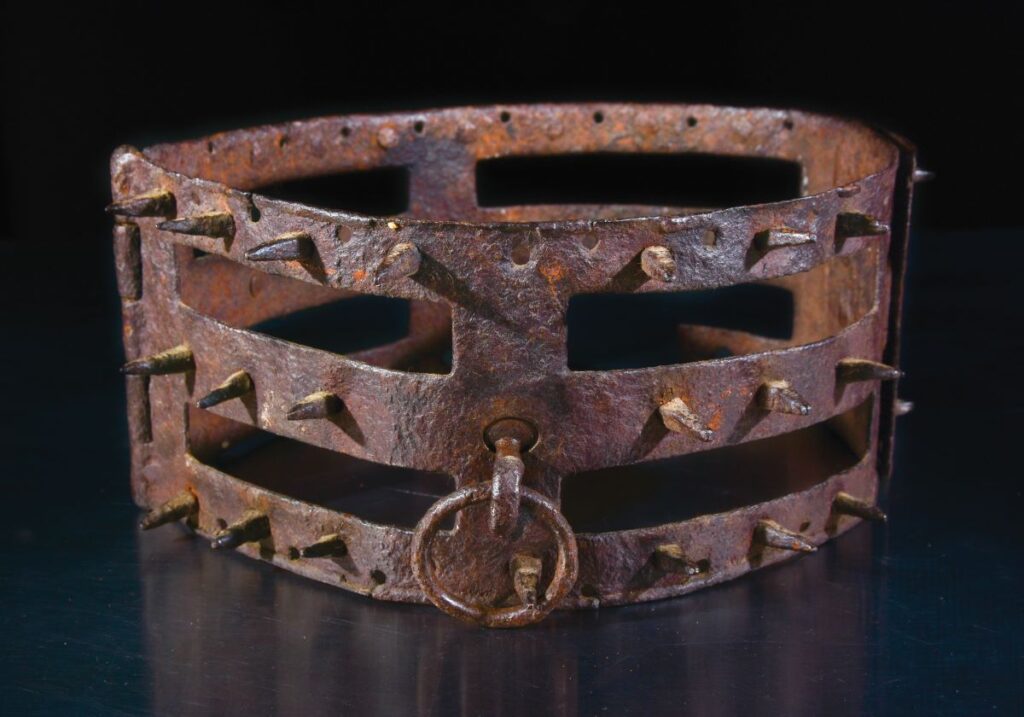
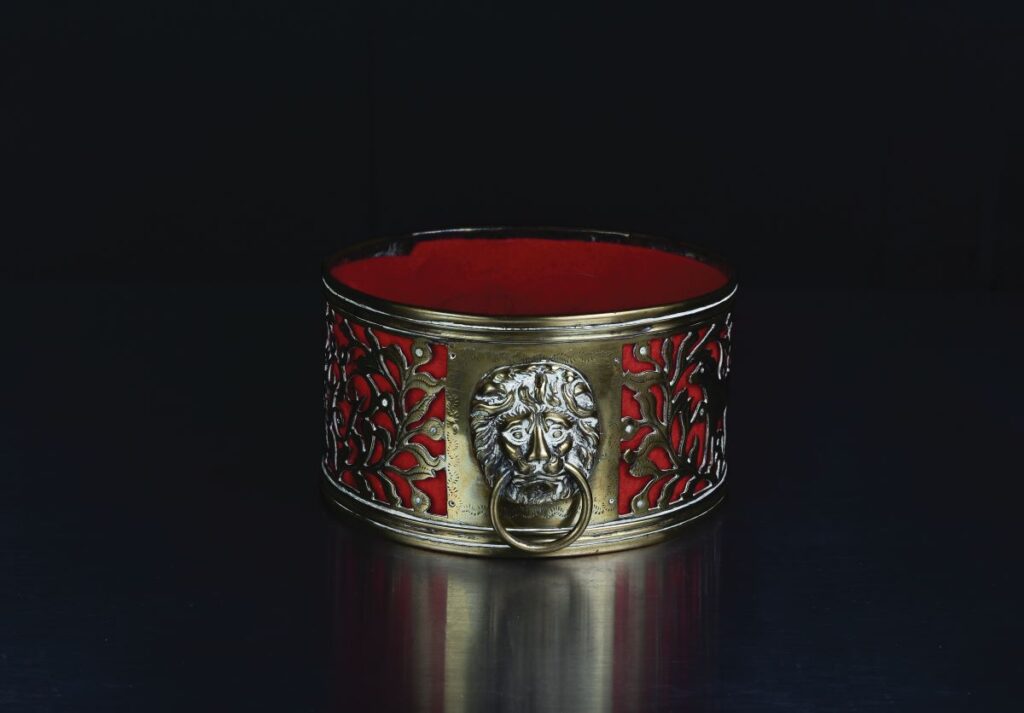
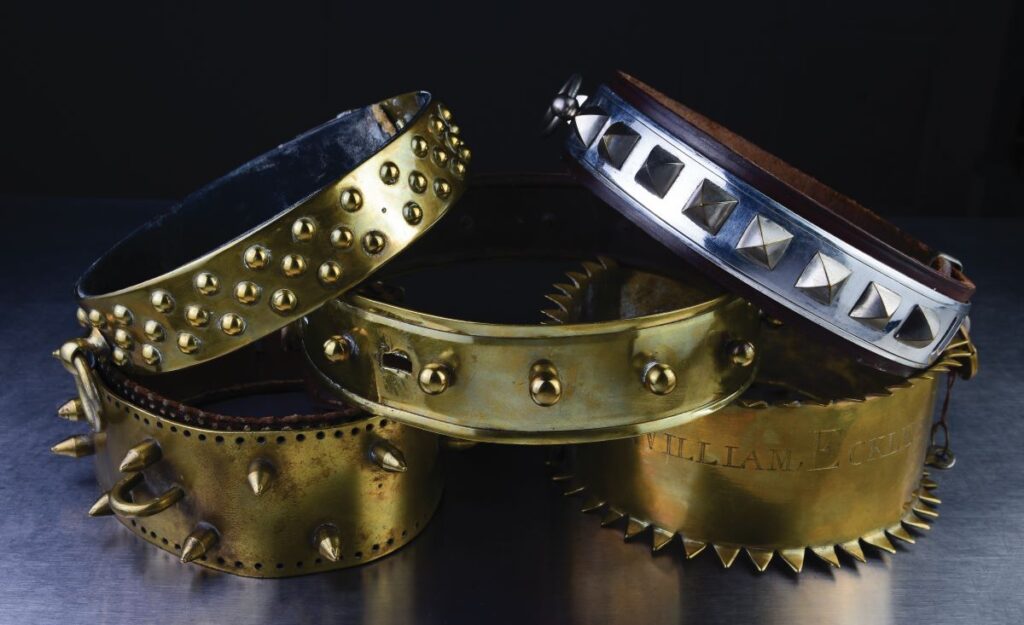
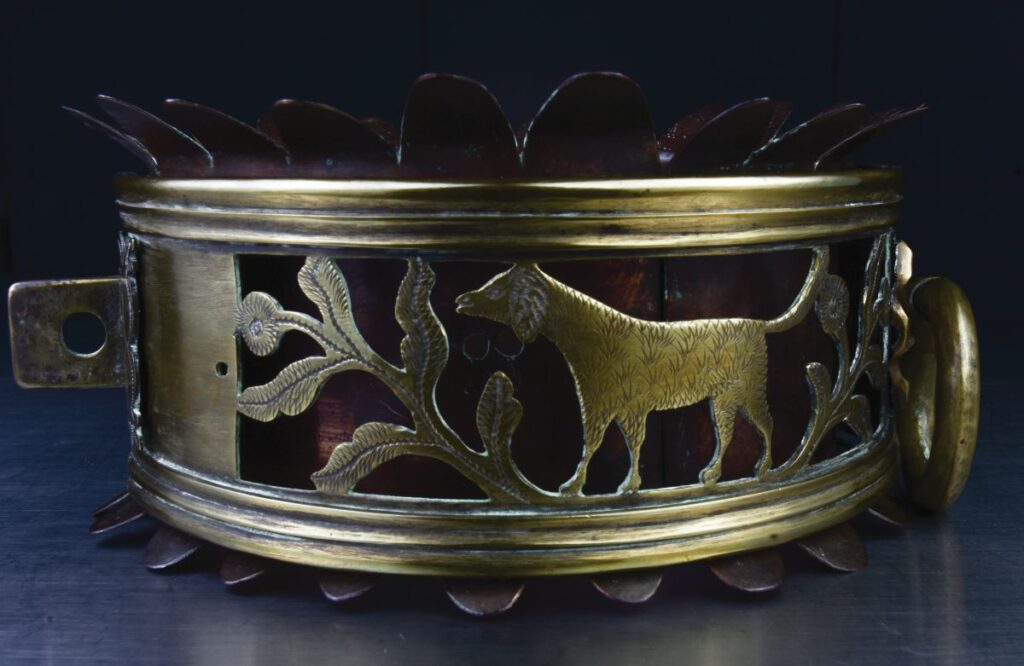
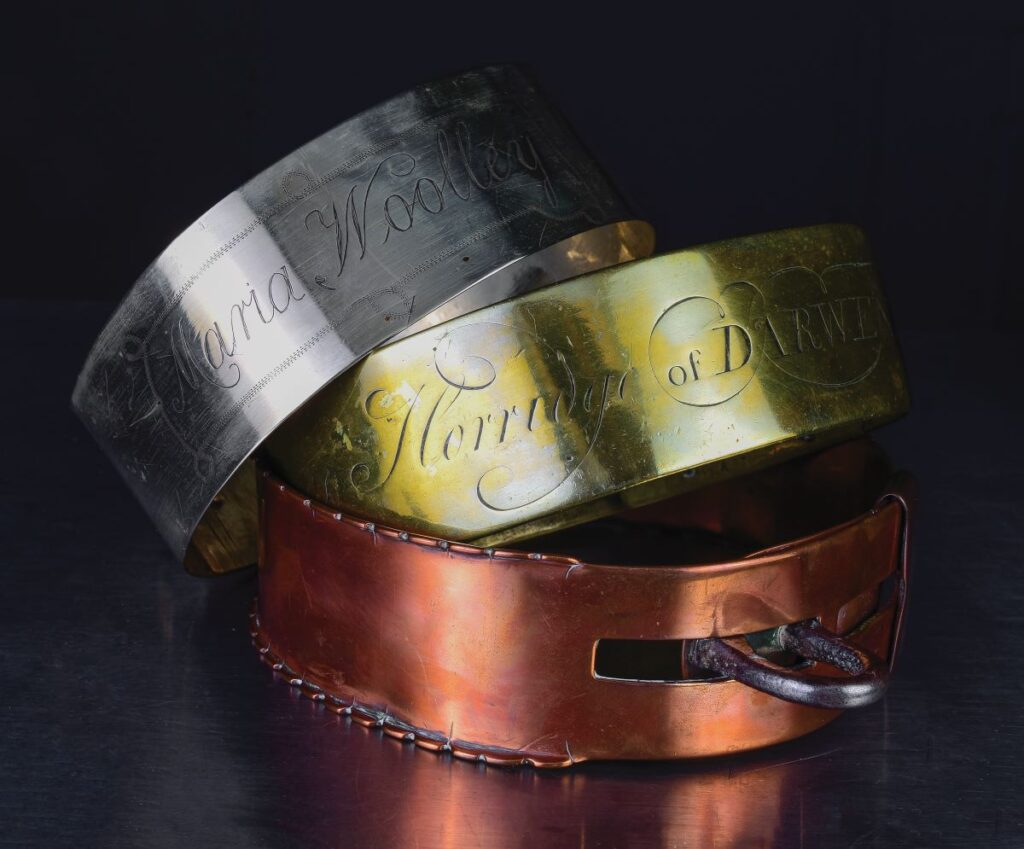
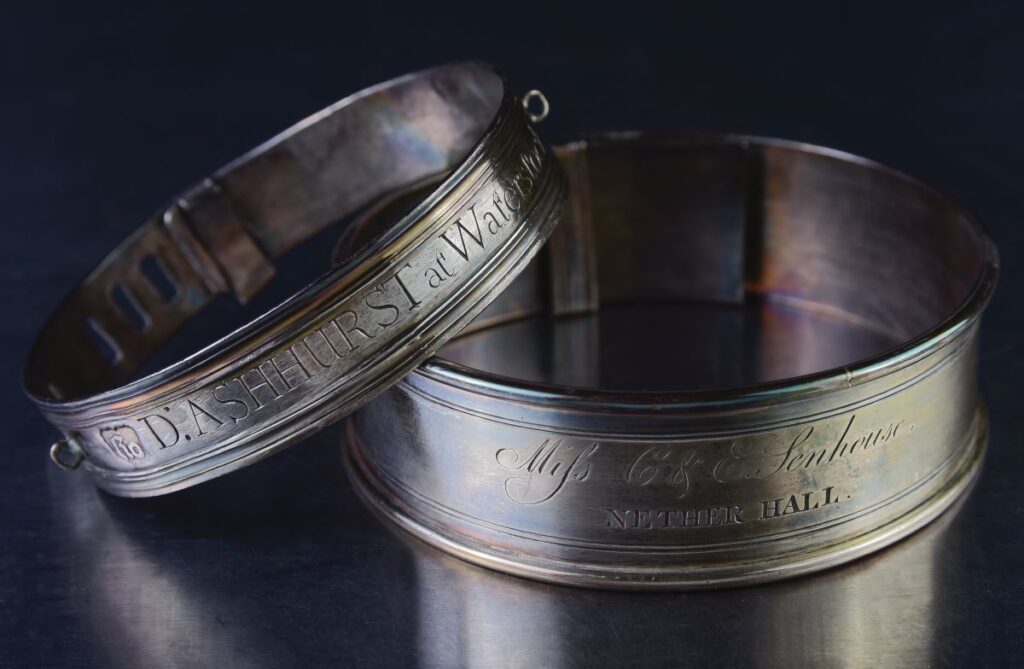
Fig. 15. Left: Dog collar, British, 1800s. Inscribed “D. ASHHURST at Waterstock” with hallmarks. Silver; height 3⁄4, diameter 3 3/8 inches. Right: Dog collar marked by George Unite (1798–1896), Birmingham, England, 1834. Inscribed “Miss C & E. Senhour,/NETHER HALL” with maker’s mark and date mark for 1834. Silver; height 1 1/8, diameter 4 inches. National Sporting Library and Museum, Greenan gifts; Pfeiffer photograph.
Some collars were used to identify the dogs who wore them, others were intended to help in the return of lost dogs to their owners. Still others were simply used to proclaim ownership. One such collar was created in 1715 to be worn by a dog owned by the future George II when he was the Prince of Wales. So intent was its maker on identifying the dog’s royal ownership that the prince’s name is given in huge block letters, but the dog’s name is not even mentioned on the collar. Perhaps this was to allow for the collar’s repeated use, or its interchange between different animals that were only collared as needed. It is now on display at Windsor Castle.
In 1736 the poet and satirist Alexander Pope (1688–1744) gave George II’s estranged son, Frederick, Prince of Wales (1707–1751), a Great Dane to help guard his estate at Kew. With it he also gave a collar engraved with an epigram certain to humiliate anyone on friendly enough terms with the prince so be able to read his dog’s collar: “I am his Highness’ dog at Kew/ Pray tell me, sir, whose dog are you?”3 It may be the most politically astute dog collar known, and a reminder that dogs, no matter how we interact with them, always have something to tell us about ourselves.
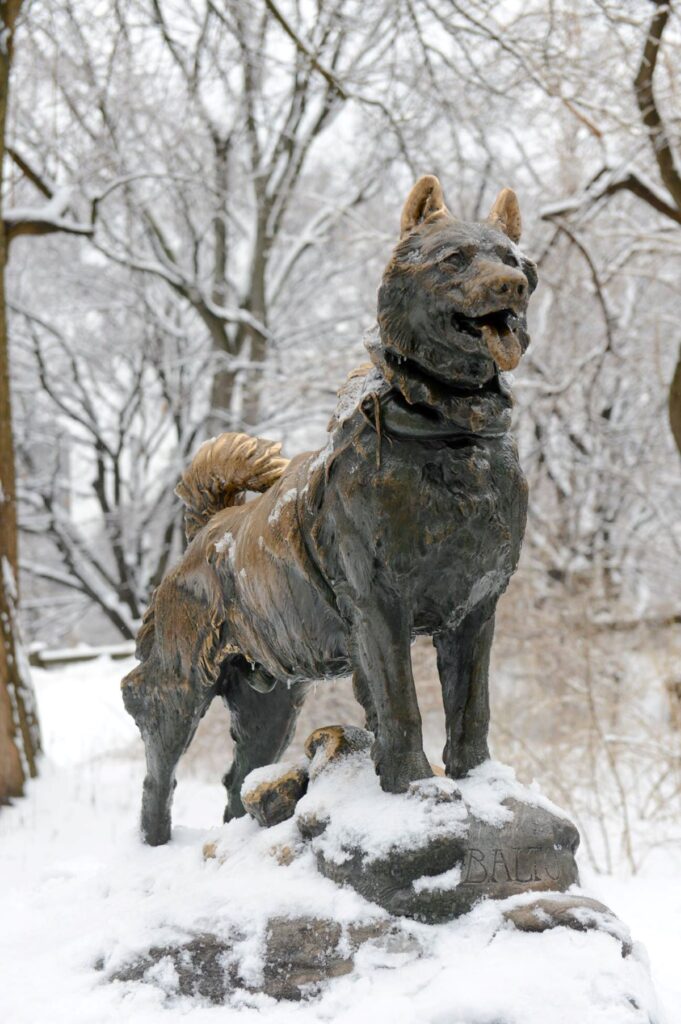
Identity and Restraint: Art of the Dog Collar will be on view at Pebble Hill Plantation in Thomasville, Georgia, from November 3 to May 3, 2024.
1 There is a third dog from Peter the Great’s era on display at the State Hermitage Museum in Saint Petersburg. I am indebted to Nadezhda Slepkova, curator the Zoological Institute of the Russian Academy of Sciences in St. Petersburg, for this information.
2 Timothy J. Greenan, Identity and Restraint/ Art of the Dog Collar (Middleburg, VA: National Sporting Library and Museum, 2022), p. 2. I am grateful to Elizabeth von Hassell, executive director of the National Sporting Library and Museum, Claudia Pfeiffer, deputy director, and George L. Ohrstrom Jr., curator of the museum, for providing illustrations from the Greenan collection for use in this article.
3 W. K. Thomas, “His Highness’ Dog at Kew,” College English, vol. 30, no. 7 (April 1969), pp. 581–586.
ROBERT MCCRACKEN PECK, Curator of Art and Artifacts and Senior Fellow at the Academy of Natural Sciences of Drexel University in Philadelphia, writes often for The Magazine ANTIQUES.

